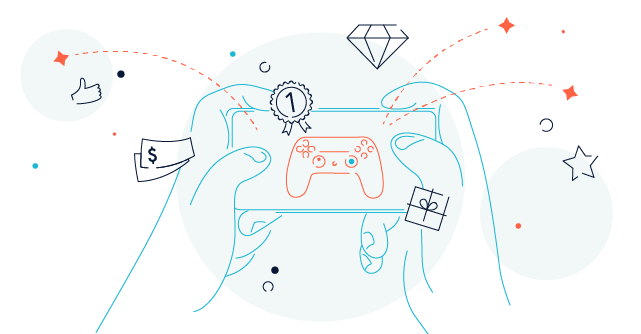We’ve come a long way from the arcade, when setting new records and acquiring gems used to be the most exciting features of games. Today, emerging trends in mobile gaming are now on course to make gaming more fun, social and rewarding.
Mobile games are becoming both more social and corporate, with an influx of top companies now sponsoring games. With over 3.24 billion gamers – about 40% of the global population – mobile gaming is increasingly becoming a common part of many people’s lives, offering more opportunities for mobile gaming reward strategies to reach, acquire and retain more customers.
Statista (2021). “Number of video gamers worldwide in 2021, by region(in millions).”
Today, the gaming market cuts across all generations and regions of the world, and the increasing demand for more new games is predicted to further propel the market’s revenue from $9.1 billion in 2020 to an estimated $30.7 billion by 2025, at a stellar compound annual growth rate (CAGR) of 27.4%.
At the forefront is mobile gaming, which is propelling this massive growth with 2 .69 of the 3 billion global gamers now accessing games via their mobile devices. Furthermore, 66% of the Apple App Store’s revenue and 83% of Google Play’s revenue in 2020 came from mobile games alone.
These numbers are only expected to grow in 2022, thus creating the increased likelihood for a variety of businesses to leverage mobile gaming reward strategies to tap new customer bases and revenue streams.
Going into 2022, we have highlighted the below 5 trends in the mobile gaming sector that industry players and observers should be watching.
1. Mobile gaming will become more inclusive
Compared to the use of gaming consoles, mobile games are more accessible to all people, and will become more so in 2022. The portability of smartphones, as well as their capacity to contain a variety of games for many kinds of people, makes mobile gaming a more inclusive proposition for users.
When Covid-19 restricted in-person contact, mobile games became windows to the outside world, as well as an adhesive for relationships between families and neighbors.
Today, mobile gamers can connect and compete easier than ever before with others across the world, and the ease of setting up mobile games have made them popular across all categories of people.
For instance, 90% of Gen-Zers identify themselves as gamers. In the United States, 64% of U.S. adults and 70% of those under 18 play video games, with the average age of a video game player between 35 to 44 years . Aside from that, mobile gaming is also increasingly inclusive for women and children, and it is a genre that is decidingly disability friendly.
Mobile game marketing strategies can be designed around wider reasons for playing mobile games, which include relaxation, mental stimulation, and to strengthen connections and relationships.
The Entertainment Software Association (2020). “2020 Essential Facts About the Video Game Industry.”
2. Mobile phone accessibility and nascent 5G technology will expand and improve the gaming experience
Mobile games are partially so popular simply because of the ubiquity of mobile phones. According to Data Reportal, there are 5.29 billion mobile phone users, accounting for 67.1% (one-third) of the world’s population, and four of five mobile phones used are now smartphones.
The number of mobile phone users increases daily, especially in emerging countries, with global mobile penetration expected to reach 80% by 2025. India, Indonesia, Pakistan, Mexico and African countries are driving the most new mobile usage, with the global number of smartphone users increasing by an average of 1 million daily.
This trend points to one conclusion – the population of potential mobile game players will only increase in years to come.
Moreover, the advent of 5G will also provide incremental and disruptive benefits for the mobile gaming industry. In 2022, the introduction of 5G will provide smoother, faster and better gaming experiences.
At the moment, the use of the internet has spread across the world with a global usage of 61.8% of the total population (4.88 billion users). Currently, most internet users rely on 4G LTE, but 5G is expected to penetrate further and reach 18% of the global customer base by 2025.
Although the adoption rate has slowed down recently due to the Covid-19 pandemic, 2022 and subsequent years will see an increase in the use of 5G, and it will ultimately have a tremendous impact on gaming.
GSMA Intelligence (2020). “Global Mobile Trends 2020 : New decade, new industry?”
In particular, 5G will result in faster and graphic-rich gaming experiences because of lower latency rates, improved multiplayer experiences, and upgraded streaming of games.
Mobile phone producers are already getting primed for 5G. 43% of active smartphones will be 5G-ready by 2023, and companies should thus tweak their mobile game marketing strategies in readiness for this revolution in 5G.
The mobile gaming industry must also be prepared for speedier gaming experiences, which will in turn require an upgrade for reward acquisition and delivery to match gamer demands.
3. Mobile gaming will become more social
Mobile games are increasingly becoming more interactive, just as console and personal computer games before them. Increased social media use, better internet connections, and the quest for interactivity – especially after the lockdowns and imposed isolation of Covid-19 – has made mobile gaming a more social arena.
According to Facebook, four in 10 (38%) new gamers in the U.S. prefer to chat while they play games, and many are beginning to prefer multiplayer/online modes compared to single player games.
Developers are taking advantage of this change in behavior by adding features such as chat rooms, social media connectivity, guilds and more. The rise of gamers and increase in social media use is now concurrently driving the socialization of gaming.
Data Reportal (2021). “Digital 2021 October Global Statshot Report”
Marketers can also explore this by delivering rewards via these new social features of mobile games. Also, they can start to leverage the interconnectedness of mobile games and social media platforms to incentivize users and deliver promotions.
4. Mobile gaming will have more spectatorship
Just like mainstream sporting events, games are attracting more spectators who get entertained from watching gamers.
A study by Limelight revealed that watching gamers play over the internet is becoming more popular among 18 to 25 year olds, even more than watching sports. Every week, 71% of millennial gamers watch video games and game-related contests for about 6 hours, according to Nielsen, a market measurement firm.
The gaming sector is experiencing massive audience growth, giving rise to a number of gaming influencers amidst a booming number of game watchers. In 2020, Alexandria Ocasio-Cortez, a US congresswoman, attracted over 400,000 viewers as she played the online game Among Us on Twitch, a live video streaming platform, as a charity activity that raised $200,000.
The diversity of the growing audience of game spectators expands the reach of gaming rewards, as they can be structured to incentivize both gamers and spectators.
5. Web 3.0 will arrive with more NFTs and play-to-earn opportunities
“Play-to-earn” is going to become more than just a trendy statement in the gaming sector, and the gamification of NFTs will offer new kinds of digital rewards that will create a novel gaming ecosystem applicable to many markets, from sports fan rewards to software developers.
In addition, the metaverse – a digital universe within a digital world – will enable opportunities that will come to define the future of gaming.
Play-to-earn games enable gamers to play and win gaming assets they can sell outside of the games. The sellable assets are often built on non-fungible tokens (NFTs), an offshoot of the gamification of the cryptocurrencies via blockchain technology.
Gamers can aquire, own and sell gaming NFTs, which are blockchain-based. The ownership of gaming assets is the key distinguishing factor when compared to conventional asset-acquiring games. This new model has also created new opportunities for sponsorship, connecting corporate investors, gamers and NFT enthusiasts in a closely-knit community.
This tokenization economy – often referred to as Web 3.0 – will usher in a new kind of internet and allow social media companies to redesign their business model. Recently, Facebook announced its entry into metaverse by changing its name to Meta, declaring it would invest $50 million in the creation of metaverse assets.
Going into 2022, the digital world and the physical world will thus become more synchronized with more assets being transferred within the metaverse.
In this way, play-to-earn and NFTs are poised to dramatically change the gaming industry.
First, play-to-earn is enabling companies to reward gamers with small financial incentives, a popular incentive in many emerging markets. For example, over 2 million people in Venezuela and the Phillipines play games daily for financial rewards, according to the World Economic Forum. One of such games is Axie Infinity, which raised $152 million at a multiple billion-dollar valuation in a Series B round led by Andreessen Horowitz. CryptoKitties, The Sandbox and War of Ants are also other popular games that are getting buzz for their novel use of rewards.
It has also led to the establishment of Play-to-Earn Guilds, a community of gamers encouraging new entrants to get started by renting gaming assets. That way, gamers can start playing without spending a lot of time acquiring assets, and they then get paid in interest from renting their gaming rewards.
These are just some of the major trends that are going to impact the future of the mobile gaming industry going into the new year.



